Sexual Reproduction | Biology for Grade 12 PDF Download
Sexual Reproduction
- Involves the formation of male and female gamete by two individuals of the opposite sex.
- Offspring produced by fusion of male and female gametes not identical to each other or to the parents.
- All sexually reproducing organisms share a similar pattern of reproduction.
- In sexual reproduction, a fusion of male and female gametes results in offspring that are not identical to parents.
Origin of Sex
- Sex originated in protistans and simple algae.
- During favorable conditions, these organisms multiply asexually but during unfavorable conditions, gametes are formed.
- The gametes seem to be starved asexual spores.
- They fuse to form zygotes which often develop a thick wall to become zygospores. The latter are dispersed.
- Under favourable conditions, zygospore germinates to form new organisms (e.g., protist/alga).
- Early sexual reproduction was isogamous.
- Later on, evolution occurred and sexual reproduction became anisogamous and oogamous.
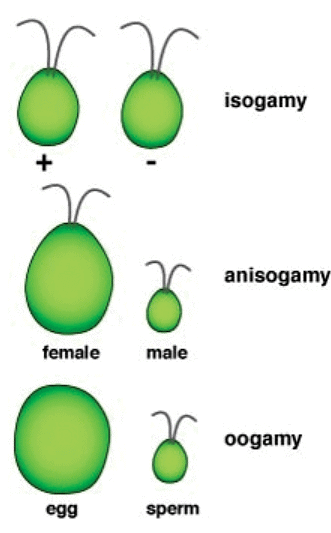
- Similarly, sex organs evolved which differentiated into male and female.
- The early evolution of sex organs depended upon the environment but later on, hormones started influencing the development of sex organs.
In Chlamydomonas sexual reproduction may be isogamous, anisogamous or oogamous.
Sexuality in Organisms
- In most primitive sexually reproducing organisms, there is no morphological or physiological difference in the functional gametes.
- The gametes belong to the same parent. Such organisms are called homothallic (bisexual condition), e.g., Mucor mucedo.
- When the functional gametes belong to different parents as in Rhizopus stolonifer, and there is no morphological or physical difference, these organisms are called heterothallic (unisexual condition).
- In higher organisms, sex organs developed, differentiated into male and female. In most flowering plants, both male and female sex organs (stamens and carpels) occur in the same flower.
- Such plants are called hermaphrodite or bisexual, e.g. sweet potato. In some flowering plants, male flowers (staminate flowers) and female flowers (pistillate flowers) are borne on different plants.
- These plants are called dioecious plants. Plants are either male or female, e.g. Date Palm, Papaya.
- When both male and female flowers are present on the same plants they are called monoecious plants, e.g., Maize, Coconut, Cucurbits. Lower plants are also monoecious and dioecious.
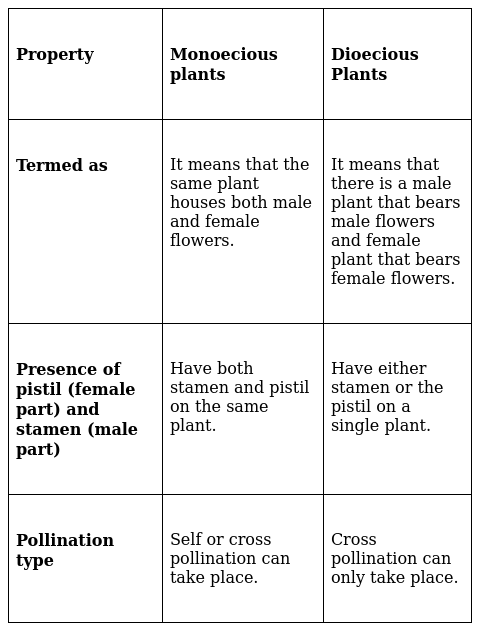
- Chara often bears both male (antheridium) and female (oogonium) sex organs. Marchantia a liverwort is dioecious.
- Here, the female plant bears archegonia over the archegoniophore. The male plant has antheridia over the antheridiophore.
Special point
• A haploid parent produces gametes by mitotic division.
• Several organisms belonging to monera, fungi, algae and bryophytes have haploid plant body, but in organisms belonging to pteridophytes, gymnosperms, angiosperms and most of the animals including human beings, the
parental body is diploid.
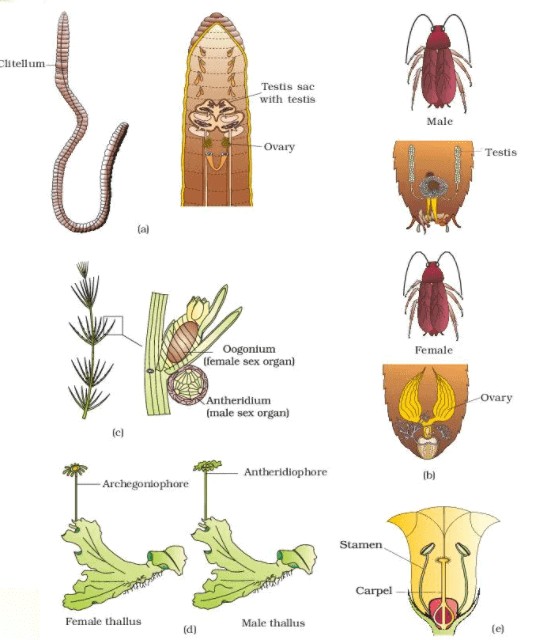

Different Phases in Sexual Reproduction
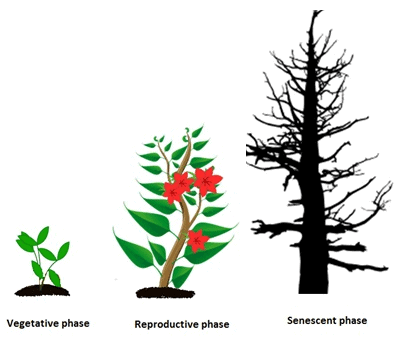 Phases of Life
Phases of Life
1. Juvenile Phase/Vegetative Phase
- The period between birth and sexual maturity is called the juvenile phase.
- In plants, it is known as the Vegetative phase.
- The end of the juvenile/vegetative phase marks the beginning of the reproductive phase.
2. Reproductive Phase
- Some plants show flowering in a particular season and some other flowers in all seasons.
- Some other plants like bamboo species flowers once in a lifetime (after 50-100 years), Strobilanthes kunthiana (neelakuranji), flowers once in 12 years.
- The female placental animals exhibit a cyclic change in activities ovaries and accessory glands as well as hormones during the reproductive phase.
(i) Menstrual Cycle: It occurs in monkeys, apes and human beings.
- The cycle consists of 3 phases-menstrual, proliferative and secretory phases.
- Blood flows in the last few days of the cycle.
- The broken endometrium is passed out during menstruation.
- Female does not permit copulation during the menstrual phase of the cycle.
(ii) Oestrous Cycle: It occurs in non-primates like cows, sheep, rats, deer, dogs, tigers etc.
- It consists of a short period of estrous or heat.
- It is 12-24 hours in cow followed by an estrous or passive period.
- Blood does not flow in this cycle.
- The broken endometrium is reabsorbed.
- Female permits copulation only during the estrous period.
- Both in plants and animals, hormones are responsible for the transition between different phases of the life cycle.
- Interaction between hormones and environmental factors regulates the reproductive processes.
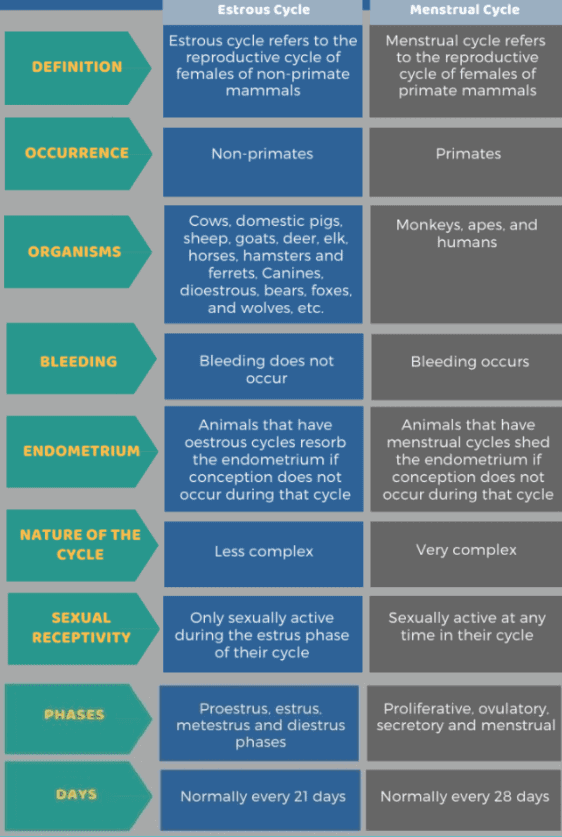 Difference between Estrous cycle and Menstrual Cycle
Difference between Estrous cycle and Menstrual Cycle
3. Senescent Phase:
It begins at the end of the reproductive phase when degeneration sets in the structure and functioning of the body.
Senescence is the last phase of the life span. It ultimately leads to death.
In both plants and animals, hormones are responsible for the change over from one phase to another.
Hormones and certain environmental factors regulate the reproductive processes and the behaviour of organisms.
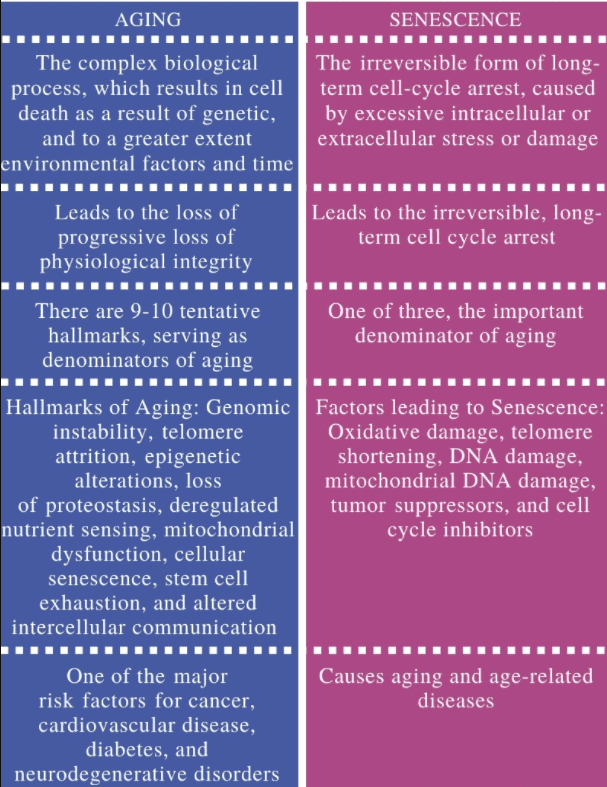 Aging V/S Senescence
Aging V/S Senescence
Events in Sexual Reproduction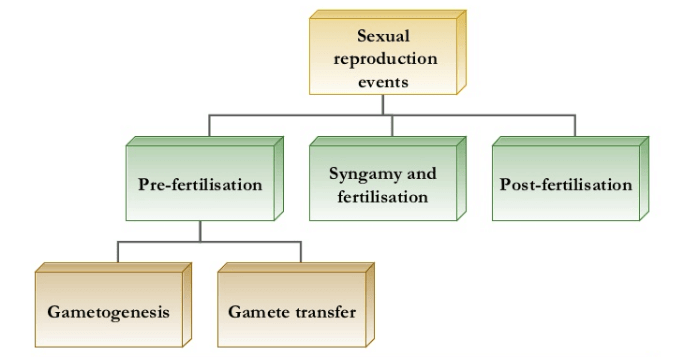

(
a)
Pre-fertilisation
All the events prior to the fusion of gametes are included in it.
It includes gametogenesis and gamete transfer:
(i) Gametogenesis
- Gametogenesis, the production of sperm and eggs, takes place through the process of meiosis.
- During meiosis, two cell divisions separate the paired chromosomes in the nucleus and then separate the chromatids that were made during an earlier stage of the cell’s life cycle, resulting in gametes that each contain half the number of chromosomes as the parent.
- The production of sperm is called spermatogenesis and the production of eggs is called oogenesis.
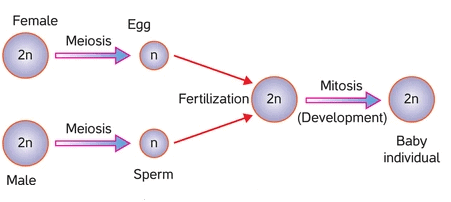
- Gametes are haploid cells that may be similar or dissimilar in structure.
- In algae, both gametes are similar in a structure called homogametic (isogametes).
- In higher organism that reproduces sexually, two morphologically distinct gametes are formed called heterogametes, male gametes are called antherozoid or sperm and female gametes are called ovum or egg.
- In fungi and plants, homothallic and monoecious terms are used to denote the bisexual condition and heterothallic and dioecious are used for unisexual conditions.
- In flowering plants, the unisexual male flower is staminate, i.e., bearing stamens, while the female is pistillate or bearing pistils.
- In animals, species that possess both male and female reproductive organs in the same individual are called bisexual or hermaphrodites (earthworm, sponges, tapeworm etc.) and both having either male or female reproductive organs are called unisexual (cockroach, human).
- Gametes are always haploid( having half set of the chromosome), although organisms may be haploid and diploid.
- Diploid organisms form gametes by meiotic division.
- The organisms belonging to algae, fungi, and bryophytes have haploid plant bodies and pteridophytes, gymnosperms, angiosperms and most of the animals are diploid (having a double set of the chromosome).
- In diploid organisms, gamete mother cell (meiocyte) undergoes meiosis in which one set of the chromosome is present in gametes.
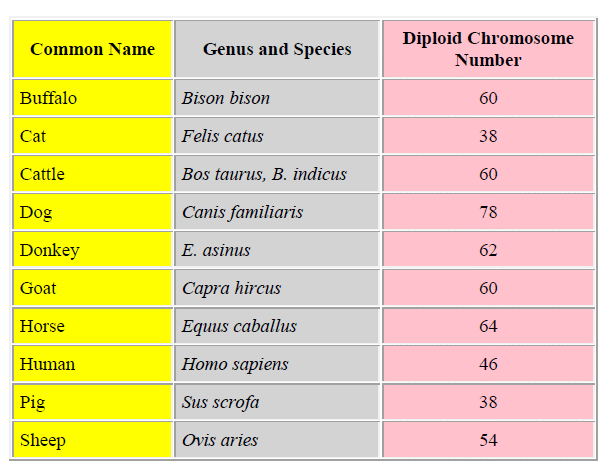 Chromosome Number (n) in different organisms
Chromosome Number (n) in different organisms
Oogenesis
- Oogenesis occurs in the outermost layers of the ovaries.
- As with sperm production, oogenesis starts with a germ cell, called an oogonium (plural: oogonia), but this cell undergoes mitosis to increase in number, eventually resulting in up to one to two million cells in the embryo.
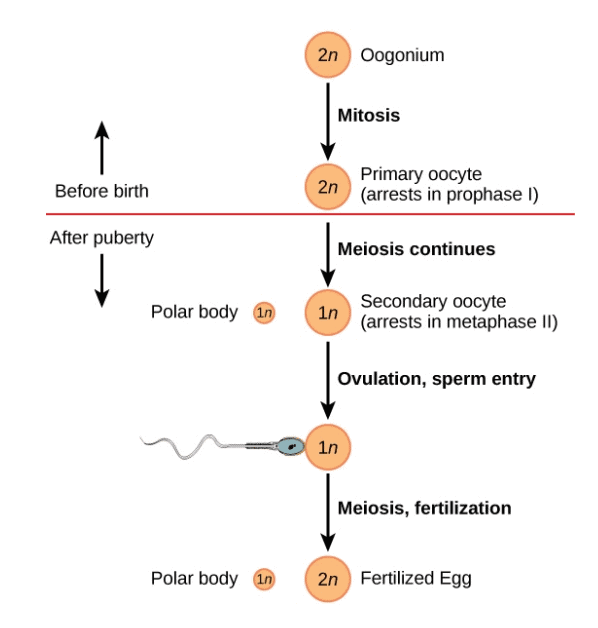
- The process of oogenesis occurs in the ovary’s outermost layer.
- A primary oocyte begins the first meiotic division but then arrests until later in life when it will finish this division in a developing follicle.
- This results in a secondary oocyte, which will complete meiosis if it is fertilized.
- The cell starting meiosis is called a primary oocyte.
- This cell will begin the first meiotic division but be arrested in its progress in the first prophase stage.
- At the time of birth, all future eggs are in the prophase stage.
- At adolescence, anterior pituitary hormones cause the development of a number of follicles in an ovary.
- This results in the primary oocyte finishing the first meiotic division.
- The cell divides unequally, with most of the cellular material and organelles going to one cell, called a secondary oocyte, and only one set of chromosomes and a small amount of cytoplasm going to the other cell.
- This second cell is called a polar body and usually dies.
- A secondary meiotic arrest occurs, this time at the metaphase II stage.
- At ovulation, this secondary oocyte will be released and travel toward the uterus through the oviduct.
- If the secondary oocyte is fertilized, the cell continues through meiosis II, completing meiosis, producing a second polar body and a fertilized egg containing all 46 chromosomes of a human being, half of them coming from the sperm.
Spermatogenesis
- Spermatogenesis occurs in the wall of the seminiferous tubules, with stem cells at the periphery of the tube and the spermatozoa at the lumen of the tube.
- Immediately under the capsule of the tubule are diploid, undifferentiated cells.
- These stem cells, called spermatogonia (singular: spermatagonium), go through mitosis with one offspring going on to differentiate into a sperm cell, while the other gives rise to the next generation of sperm.
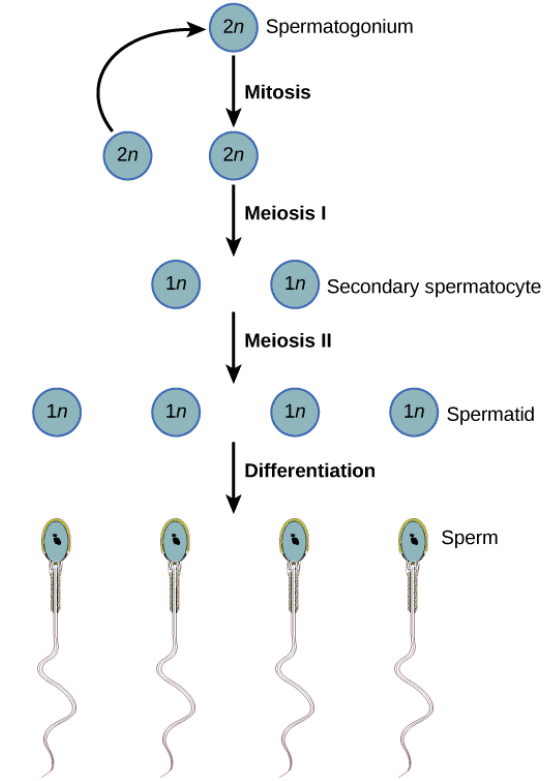
- During spermatogenesis, four sperm result from each primary spermatocyte, which divides into two haploid secondary spermatocytes; these cells will go through a second meiotic division to produce four spermatids.
- Meiosis begins with a cell called a primary spermatocyte.
- At the end of the first meiotic division, a haploid cell is produced called a secondary spermatocyte.
- This haploid cell must go through another meiotic cell division.
- The cell produced at the end of meiosis is called a spermatid.
- When it reaches the lumen of the tubule and grows a flagellum (or “tail”), it is called a sperm cell.
- Four sperm result from each primary spermatocyte that goes through meiosis.
- Stem cells are deposited during gestation and are present at birth through the beginning of adolescence but in an inactive state.
- During adolescence, gonadotropic hormones from the anterior pituitary cause the activation of these cells and the production of viable sperm.
- This continues into old age.
(ii) Gamete Transfer
- In the majority of organisms, male gametes are motile and female gametes are non-motile, except in fungi and algae in which both gametes are motile.
- In simple plants like algae, fungi, bryophytes and pteridophytes, water is the medium through which male and female gametes move.
- The number of male gametes is much more than the number of female gametes as most of the male gametes fail to reach the female gametes.
- In higher plants, pollen grains are a carrier of male gametes and the ovule has eggs. Pollen grains must be transferred from anther to stigma to facilitate fertilization.
- The transfer of pollen grains from anther to stigma is called pollination.
- Pollination may be self (anther to the stigma of the same flower) or cross (anther to the stigma of a different flower).
- Pollen grains germinate on stigma to produce a pollen tube that delivers the male gametes near the ovule.
(b) Fertilisation
- Fertilization is the fusion of gametes to form a diploid zygote. This process is also called syngamy.
- The terms syngamy and fertilization are frequently used interchangeably.
Where does fertilization occur?
- Fertilization occurs either in an external medium (water) or inside the body of the organism. Thus there are two types of gametic fusion, namely external fertilization and internal fertilization.
(i) External Fertilization.
- When fertilization occurs outside the body of the organism, the gametic fusion is called external fertilization or external syngamy.
- It generally occurs in an aquatic medium.
- Common examples are algae, fishes, and amphibians.
- Organisms exhibiting external fertilization produce a large number of gametes in water to enhance the chances of fertilization.
- This happens in bony fishes and frogs where a large number of offspring are produced.
- A major disadvantage of this type of fertilization is that the offspring are not protected from the predators and their survival is threatened up to adulthood.
(ii) Internal Fertilization.
- It is a fusion of gametes inside the body of the female.
- Internal fertilization or internal syngamy occurs in terrestrial organisms belonging to fungi, higher animals such reptiles, birds and mammals and a majority of bryophytes, pteridophytes, gymnosperms and angiosperms are the examples where internal fertilization occurs.
- Here male gamete is mobile and has to reach the egg in order to fuse with it.
- The number of sperms produced is very large but there is a reduction in the number of eggs produced.
- However, in seed plants, the non-motile male gametes are carried to the female gamete by pollen tubes.
 Difference between External and Internal Fertilization
Difference between External and Internal Fertilization
(c) Post Fertilisation Events
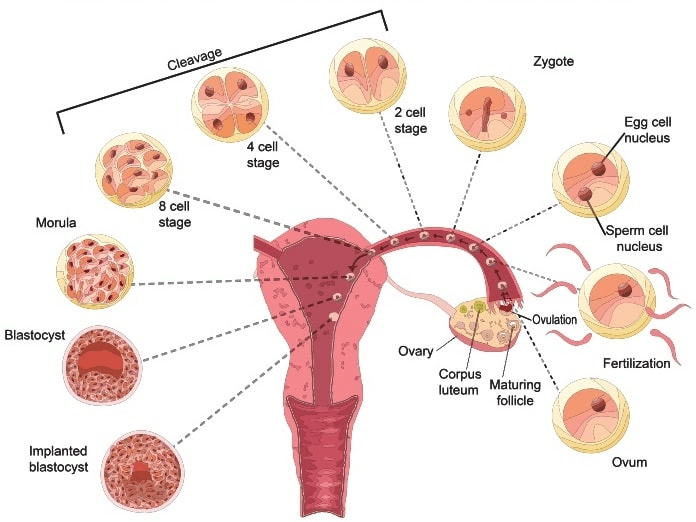 Fetal development from ovulation to implantation
Fetal development from ovulation to implantation
(i) The Zygote
- Events in the sexual reproduction after the formation of zygote.
- A zygote is a vital link that ensures continuity of species between organisms of one generation and the next.
- Every sexually reproducing organism, including human beings, begins life as a single cell–the zygote.
- In the organisms, having external fertilization, the zygote is formed in an external medium (water) and those having internal fertilization zygote is formed inside the body of the female.
- In algae and fungi, the zygote develops a thick wall resistant to desiccation and damage. This germinates after a period of rest.
- In the organisms having a haplontic life cycle, the zygote divides to form haploid spores that germinate to form haploid individuals.
(ii) Embryogenesis
- The process of development of an embryo from the zygote.
- During this, the zygote undergoes mitotic division and cell differentiation.
- Cell division increases the number and cell differentiation helps the information of a new group of cells and organs.
- On the basis of the development of the zygote, animals are grouped into oviparous, viviparous and ovoviviparous.
- The oviparous animals lay fertilized or unfertilized eggs.
- Inland animals such as reptiles and birds the fertilized eggs are covered by hard calcareous shells and are laid in a safe place in the environment.
- After the incubation period, young ones hatch out. In viviparous animals such as the majority of mammals including human beings, the zygote develops into a young one inside the body of the female individual.
- After a certain growth, the young ones are delivered by the female individual.
- Due to proper care and protection, the chances of survival of young ones are more in viviparous, individuals.
- In ovoviviparous animals, the female retains the eggs inside its body after fertilization and allows the development of the embryo inside the body without providing extra nourishment to the developing embryo as the placenta is absent.
- However, the female animals give birth to the young ones. Examples of ovoviviparous animals are sharks and rattlesnakes.
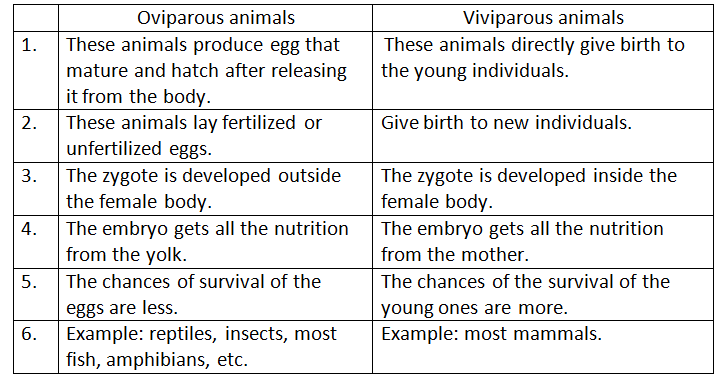
- In flowering plants, the zygote is formed inside the ovule of the female sex organ.
- After fertilization, the sepals, petals and stamens of the flower become faded and fall off.
- The sepals may remain attached as in Hibiscus.
- However, the pistil remains attached to the plant.
- Seed and Fruit Formation. In angiosperms, double fertilization produces two structures a diploid zygote (= oospore) and a triploid primary endosperm cell.
- Zygote forms the triploid primary endosperm cell gives rise to a nutritive tissue called endosperm.
- The endosperm provides food to the growing embryo.
- The fertilized ovules mature and convert into seeds.
- The wall of the ovary forms the pericarp (fruit wall).
- The ripened ovary with pericarp and seeds is called fruit.
- The pericarp protects the young seeds.
- After dispersal, the seeds germinate to form new plants.
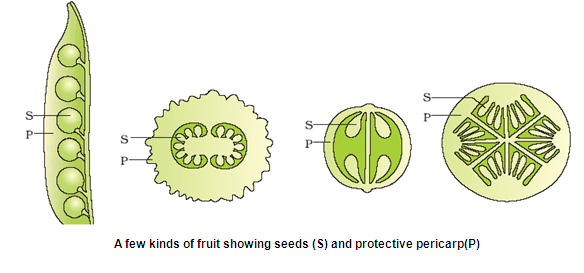
Advantages of Sexual Reproduction (Why is sexual reproduction better than asexual reproduction?)
1. Variations. Since fusion of gametes from different parents occurs during sexual reproduction, hence genetic recombination takes place causing variations.
2. Evolution. Variation is a major factor of natural selection, therefore, it plays an important role in evolution.
3. Adaptation. The offspring produced due to reproduction adapt better to the
changing environmental conditions.
4. Vigour and Vitality. Genetic recombination and interaction during sexual reproduction provide vigour and vitality to the offspring.
Disadvantages of Sexual Reproduction
1. Sexual reproduction is usually biparental.
2. It is a slow process and requires a lot of time.
3. Fertilization has a chance factor.
|
124 videos|215 docs|236 tests
|
FAQs on Sexual Reproduction - Biology for Grade 12
| 1. What is the origin of sex in organisms? |  |
| 2. What is the significance of sexuality in organisms? |  |
| 3. How does sexual reproduction occur in organisms? |  |
| 4. What are the advantages of sexual reproduction over asexual reproduction? |  |
| 5. Can organisms switch between sexual and asexual reproduction? |  |
















